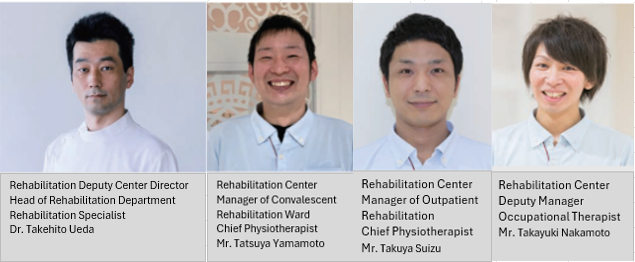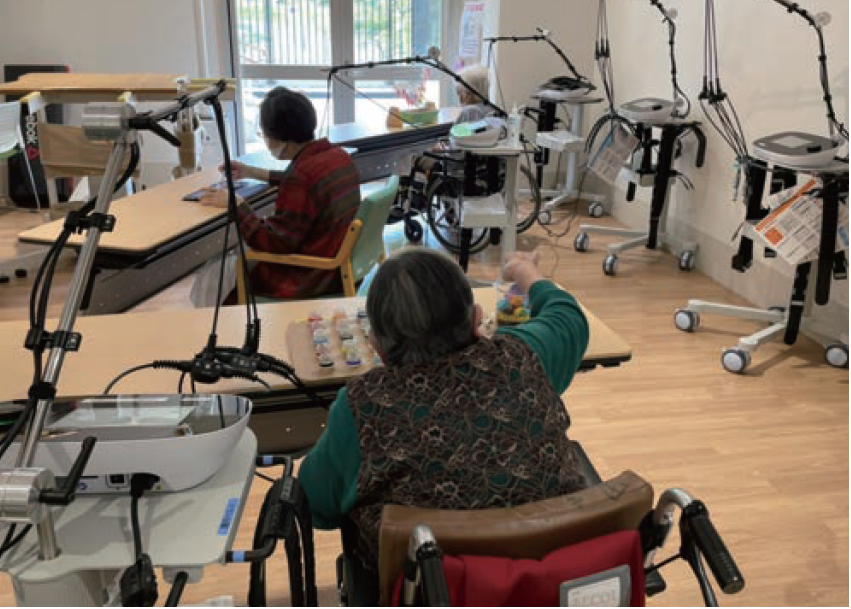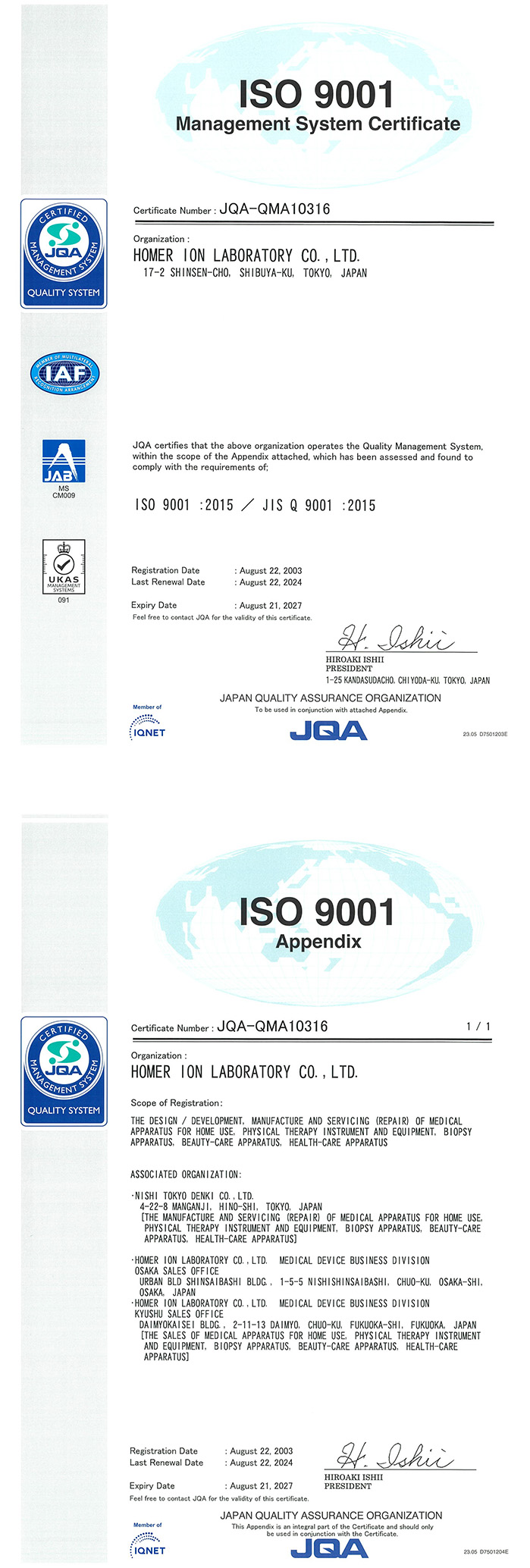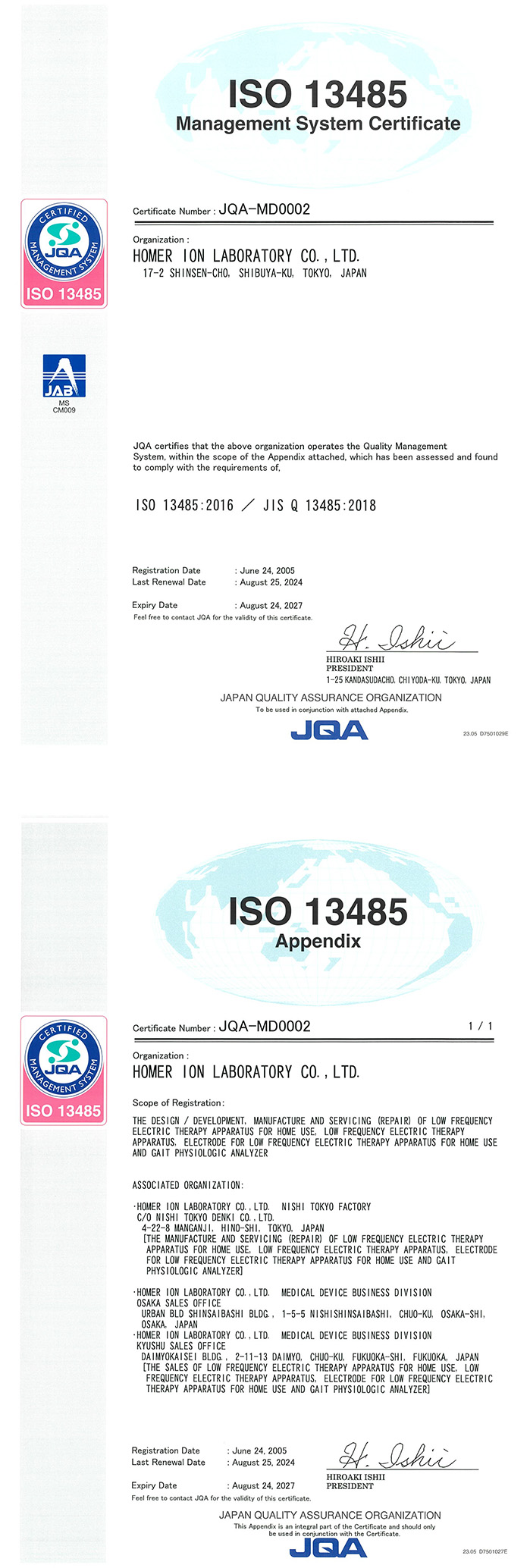


17 units of G-TES are operated across various departments, including the convalescent ward, community-based integrated care, outpatient rehabilitation, and medical fitness.

Merry Hospital is a comprehensive hospital with three functions: a convalescent rehabilitation ward, a community-based integrated care ward, and a palliative care ward. Out of the total 199 beds, 102 are in the convalescent rehabilitation ward, where rehabilitation is the main focus. One of the hospital’s key roles in the community is to receive referrals from other emergency hospitals and provide follow-up care. On the upper floors of our facility, there is a senior housing complex with medical and functional recovery services called Merry Days. Merry Days is characterized by its residents requiring medical care and high-level nursing care. Additionally, many of the individuals who move into Merry Days after being discharged from Merry Hospital also utilize our outpatient rehabilitation services. The most distinctive feature of our facility is that Merry Hospital and Merry Days are located in the same building, creating a comprehensive facility that integrates both hospital and residential services.
At the medical department of Merry Hospital, approximately 10 units of B-SES are used. In general, 8 to 9 units are used in the 102-bed convalescent rehabilitation ward, and 1 to 2 units are used in the 50-bed community-based integrated care ward. The convalescent rehabilitation ward has a rehabilitation room, and units are moved to the ward as needed for treatment. In outpatient rehabilitation, short-term outpatient rehabilitation sessions of 1 to 2 hours are conducted using the rehabilitation space in the convalescent rehabilitation center. The number of B-SES units used is 4 to 5. Each outpatient rehabilitation session lasts 1 to 2 hours, with two sessions conducted in the morning. Each session involves approximately 15 to 20 people, and each person uses B-SES for about 20 minutes. In other facilities, 2 units are used in the medical fitness area. Medical fitness is a facility for healthy individuals and is not covered by medical or long-term care insurance. Currently, B-SES is being used in the convalescent rehabilitation ward, community-based integrated care, outpatient rehabilitation, and medical fitness.
Securing Exercise Volume with B-SES from Recovery to Lifestyle Stages, Differentiating from Others
Since the opening of the hospital in 2018, B-SES was introduced primarily for use in the convalescent rehabilitation ward. At the time of opening, 7 units were introduced in the convalescent rehabilitation ward, and 3 units in the medical fitness area, totaling 10 units. Before this, rehabilitation mainly consisted of massage and manual therapy, which did not provide sufficient exercise. One of the challenges was that when patients were discharged from the convalescent rehabilitation ward and entered the lifestyle phase, their exercise volume significantly decreased. Therefore, at the time of opening, the goal was to create a new convalescent rehabilitation ward where patients could engage in consistent exercise during their hospitalization, even for those with severe conditions, ensuring exercise volume and improving overall quality of life from an early stage. The idea was to use B-SES as a tool to differentiate from other convalescent rehabilitation wards. This approach reflects the philosophy of the institution, which is a part of a group with a strong foundation in facilities and hospitals focused on the lifestyle phase of care.
The goal is to continue maintaining physical strength and function even during the lifestyle phase.
In the convalescent rehabilitation ward, the main patients are those with cerebrovascular disorders, spinal cord injuries, post-surgical fractures or joint diseases, and those with post-pneumonia disuse syndrome. Therefore, B-SES is primarily used for patients entering the convalescent rehabilitation stage.However, among these patients, some may refuse rehabilitation or find it difficult to engage. For these individuals, B-SES serves as an alternative that they are willing to use. Alongside basic rehabilitation exercises, B-SES is also used to promote muscle hypertrophy and circulation, providing synergistic effects.In the community-based integrated care ward, some patients who live at home may experience gradual muscle weakness and loss of appetite, eventually requiring hospitalization. For these patients, B-SES is used in combination with exercise while assessing their nutritional status. Additionally, as many of our patients are severely ill, one significant advantage of B-SES is that even patients who have difficulty with voluntary strength training can still utilize it. The community-based integrated care ward has a characteristic feature: the hospitalization period and rehabilitation time are shorter than in the convalescent phase, so efficient rehabilitation in a short period is essential. For patients who have difficulty getting up or those who want to increase their exercise volume, B-SES is used. While the primary focus is on exercise therapy and movement, B-SES is used as an additional aid for patients with severe conditions who have difficulty moving or cannot sit up.Another point regarding our hospital overall is that the average age of hospitalized patients is in their 80s, which is a characteristic feature. Older patients often face challenges in maintaining long-term exercise. B-SES allows even these individuals to engage in muscle training for extended periods.
Individuals who have been discharged from the hospital and returned home, as well as those staying at Meri Days, located above Meri Hospital, are scheduled to use outpatient rehabilitation. The purpose of this rehabilitation is to stabilize daily living activities through muscle strengthening, and for individuals with more severe conditions, to alleviate muscle tension and maintain the range of motion. For those who find it difficult to exercise due to pain, B-SES is also used. Generally, it is targeted at elderly individuals whose physical strength has declined, or those who find muscle training difficult or are unable to move due to pain. These are the individuals we focus on for this service.
There are about 200 residents in Meri Days. Many of the residents express a strong desire for rehabilitation. For these individuals, we offer home rehabilitation and outpatient rehabilitation services under the long-term care insurance system. Those who are able to stay out of bed for extended periods participate in outpatient rehabilitation, while those who find it difficult to leave their beds are provided with home rehabilitation services.
Those who come to the medical fitness center are generally independent in daily life, with a strong focus on improving physical fitness and maintaining muscle strength. The emphasis is more on health promotion in daily life rather than rehabilitation for those who cannot move.Those who are already interested in exercise and want to increase their activity level, or those using power rehabilitation machines who wish to add more to their workout, tend to use B-SES. This is for those who want to enhance their workout in addition to power rehabilitation.In response to the treatment effects, G-TES has been added with the expansion of the facility.

Simply put, having multiple units allows us to provide treatment to various patients at the same time. In a convalescent rehabilitation ward, there are a large number of rehabilitation staff.If there were only one or two devices, only one or two patients could use them during a given time slot. Since therapists provide one-on-one sessions to around 20 to 30 patients during the same time period, having multiple units is essential in order to deliver treatment to as many people as possible.The image is that therapists are constantly going around the ward with a dedicated cart equipped with G-TES devices. As most patients are elderly and need to exercise no matter what, B-SES is highly valued by the staff for its wide applicability and few contraindications. Even within convalescent rehabilitation wards, some hospitals have many younger patients in their 40s and 50s, while others—like ours—mainly treat patients in their 80s. At our hospital, the majority are elderly patients who require consistent physical activity, and most of them are in a state where they need some form of exercise support. The fact that B-SES can be used with few restrictions matches the needs of our facility very well.
When the facility first opened, the convalescent rehabilitation ward had 49 beds. That number has since doubled to 102 beds, so naturally, the number of eligible patients has increased significantly. We have maintained our policy of differentiating our convalescent rehabilitation ward by using B-SES, and we plan to continue in that direction. If, after trying it, we had found it wasn’t the right fit, we might not have continued with its implementation. However, since we have clearly seen its effectiveness, we decided to double the number of B-SES units in line with the increase in beds. Patients who experienced the benefits of B-SES during their stay in the convalescent ward have also expressed a desire to continue using it in outpatient rehabilitation.
As mentioned earlier, there are quite a few patients who say they won’t do regular rehab, but they will do B-SES. It’s not that they’re refusing rehabilitation altogether—but that’s how well-received B-SES is. It doesn’t cause pain, and patients seem to feel that the electrical stimulation gives them a sense that they are actively being treated. We haven’t heard any negative feedback from patients. Of course, there are some who aren’t very fond of electrical stimulation, but even in those cases, using it helps pave the way for further rehabilitation. They seem to feel that it helps move things forward. We often hear patients say things like, “Please give me the electric treatment.” Naturally, we always provide a proper explanation of the effects before using it, but patients don’t seem to have any unpleasant impressions. For example, even when we say, “This will build muscle even without movement,” it doesn’t lead them to think, “Then I don’t need rehab.” In that sense, it’s a very easy tool for us to work with. It’s also common to see patients using B-SES while watching TV after completing their rehabilitation sessions. In that sense, we feel that patient feedback has been very positive.In outpatient rehabilitation, many patients have already used B-SES during their time in the convalescent ward. Some have even chosen outpatient rehab specifically because they wanted to continue the same kind of physical therapy after discharge.Since the number of units available in outpatient rehab is limited, some patients say, “I want to be the first one to use it.”It’s surprising how even patients with dementia seem to remember and ask for the device—it seems to leave a strong impression. Its use in the community-based integrated care ward has expanded in the same way as in outpatient rehabilitation. Patients who had previously used B-SES in the convalescent ward voiced their desire to continue, and as more facilities opened, usage gradually spread. We started by using it with patients in the convalescent rehab ward to verify its safety and effectiveness, and once confirmed, we extended its use to the integrated care ward. Currently, there are many elderly individuals, including those with dementia, whose activity levels have declined significantly.In this context, B-SES fits perfectly with its catchphrase: “Eliminating the inability to exercise.”
The biggest advantage for our facility is that by introducing a large number of B-SES units, we are able to provide effective muscle strengthening training. This has become a defining feature of our facility and serves as a key point we can proudly promote.
-Effects Felt by Patients
In the medical division, we can definitely see that muscle strength improves in patients who are able to engage in physical activity. However, for patients with higher levels of severity, our challenge lies in how to achieve visible changes in muscle strength.In the convalescent phase, we provide close support through individualized rehabilitation and movement training. Muscle strengthening is addressed by incorporating B-SES as a supplementary effect. This combination leads to a positive cycle—patients are able to exercise, which builds muscle strength and physical endurance, allowing us to further enhance their treatment with B-SES, leading to even greater improvement. We truly feel this beneficial cycle is happening. For users of our outpatient rehabilitation services, who typically attend two to three times a week, we’ve observed increases in lower limb muscle mass and improvements in their ability to perform daily activities. We’ve also heard reports that patients who used to fall frequently are now experiencing fewer falls in their rooms. We’ve often been asked by patients, “Can I do the electrical therapy?” For example, patients who have already reached their limit of reimbursed rehab days under the medical fee system still inquire, “Can I at least continue the electrical therapy?” In that sense, people who have seen our website contact us even before admission with such inquiries. We’ve had family members respond positively, and even people from outside the prefecture have asked if they could visit us after discharge just to continue using B-SES.
Basically, we use the “disuse atrophy mode” for about 20 minutes as a standard guideline. This is a shared understanding throughout the hospital. Since our rehabilitation physicians are well-versed in B-SES, we operate the system in consultation with them.For example, when we want to reduce the load on a patient slightly, we switch to the “metabolic mode.”For most patients, the main goals are to prevent disuse atrophy and to increase muscle strength.However, depending on the individual’s condition, such as in cases of severe heart failure, we sometimes apply the metabolic mode as a form of aerobic exercise to supplement physical activity.
At our hospital, B-SES is currently provided as part of disease-specific rehabilitation.In the community-based integrated care ward, due to the nature of the hospital and ward functions, disease-specific rehabilitation is not applicable for some patients. However, we still try to stay involved with these patients. While there is always a physician’s order, we also offer B-SES as a service even to those not eligible for disease-specific rehabilitation. This is one of the unique features of our community-based integrated care ward. In the day-care rehabilitation setting, B-SES is provided within the scope of long-term care services. As for medical fitness, which uses machines and training equipment, it is based on a membership system. For those who wish to use B-SES there, we charge an additional fee of 500 yen per use.The first one or two sessions can be tried for free. After that, users who feel the effect pay each time they use the device.Many of those who experience the benefits after their initial use choose to use B-SES every time they come to fitness.

